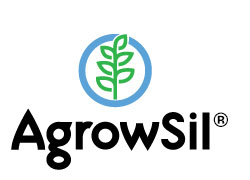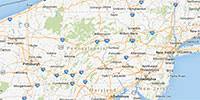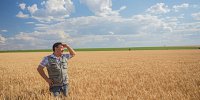No-Till Farming Practices in the USA
No-till - also known as conservation agriculture, zero tillage, direct drilling, or chemical agriculture - is a method for growing crops or pasture grasses without disturbing the soil by plowing. No-till farming was first popularized in the USA after World War II, as chemicals were introduced as a substitute for tillage.
Herbicides are used for weed control. According to the United States Department of Agriculture’s (USDA’s) 2010 publication “No-Till” Farming Is a Growing Practice, approximately 35.5% of cropland in the USA in 2009, planted to eight major crops (barley, corn, cotton, oats, rice, sorghum, soybeans and wheat), used no-till farming practices. These eight crops constituted 94% of all US farm acreage, accounting for 88 million acres.
Some of the benefits from no-till farming include: conserving water by reducing soil water evaporation, minimizing soil erosion losses and increasing biological activity by stabilizing the soil with either crop residues or cover crops; carbon sequestration by retaining organic matter and crops residues in the soil; and reducing energy needs, labor costs and agricultural fossil fuel emissions with less time and equipment passes required in preparing the soil for planting of crops. These no till advantages may be limited in areas where crop residues are removed for other uses such as forage or fuel and where poorly drained, clayey soils with wet and cold springs reduce crop yields. No-till also requires investment in specially designed planters which can increase initial or conversion costs although lower labor, energy, and machinery needs should reduce costs overtime. Other advantages of no-till include, increased soil fertility, enhanced production stability and yields, and incorporation of new areas into production. But when considering all these advantages, the overwhelming reason for not incorporating no-till into farming practices is due to the increased inputs of herbicides required for weed control.
Those who still prefer tillage use it to loosen the soil so that oxygen and water can reach the plant root zone allowing for better root growth, and as a method for weed control. However, the use of plowing and disking over time can result in the formation of a heavily compressed layer (known as plow pan or hard pan) beneath the reach of the plow which reduces water flow and deep root penetration. Additionally, which each pass across the field with heavy equipment the soil becomes more compacted beneath the wheels. Other benefits claimed for plowing include incorporation of crop residues and fertilizers into the soil where nutrients are more available for plant root uptake.
Lack of adequate machinery, herbicides and education along with cultural and policy changes are often mentioned as barriers to a global transition from till to no-till farming.


